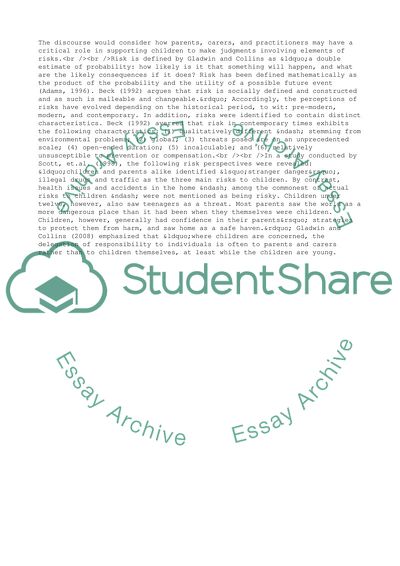Cite this document
(Protecting Children from Risk versus Encouraging Them to Develop Coursework, n.d.)
Protecting Children from Risk versus Encouraging Them to Develop Coursework. https://studentshare.org/management/1725507-explore-the-dilemma-that-parents-carers-and-practitioners-face-between-protecting-children-from-risk-while-encouraging-them-to-develop-effective-skills-in-risk-management-in-examining-this-debate-consider-how-parents-carers-and-practitioners-may-have
Protecting Children from Risk versus Encouraging Them to Develop Coursework. https://studentshare.org/management/1725507-explore-the-dilemma-that-parents-carers-and-practitioners-face-between-protecting-children-from-risk-while-encouraging-them-to-develop-effective-skills-in-risk-management-in-examining-this-debate-consider-how-parents-carers-and-practitioners-may-have
(Protecting Children from Risk Versus Encouraging Them to Develop Coursework)
Protecting Children from Risk Versus Encouraging Them to Develop Coursework. https://studentshare.org/management/1725507-explore-the-dilemma-that-parents-carers-and-practitioners-face-between-protecting-children-from-risk-while-encouraging-them-to-develop-effective-skills-in-risk-management-in-examining-this-debate-consider-how-parents-carers-and-practitioners-may-have.
Protecting Children from Risk Versus Encouraging Them to Develop Coursework. https://studentshare.org/management/1725507-explore-the-dilemma-that-parents-carers-and-practitioners-face-between-protecting-children-from-risk-while-encouraging-them-to-develop-effective-skills-in-risk-management-in-examining-this-debate-consider-how-parents-carers-and-practitioners-may-have.
“Protecting Children from Risk Versus Encouraging Them to Develop Coursework”. https://studentshare.org/management/1725507-explore-the-dilemma-that-parents-carers-and-practitioners-face-between-protecting-children-from-risk-while-encouraging-them-to-develop-effective-skills-in-risk-management-in-examining-this-debate-consider-how-parents-carers-and-practitioners-may-have.


